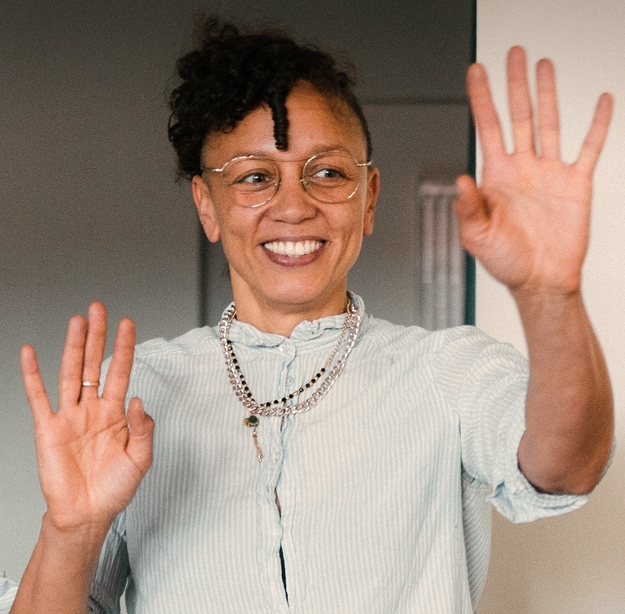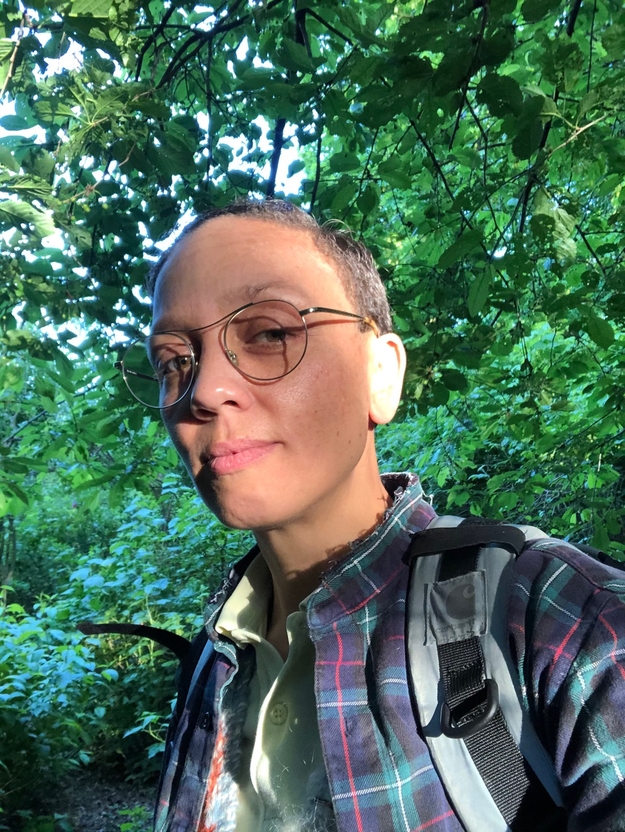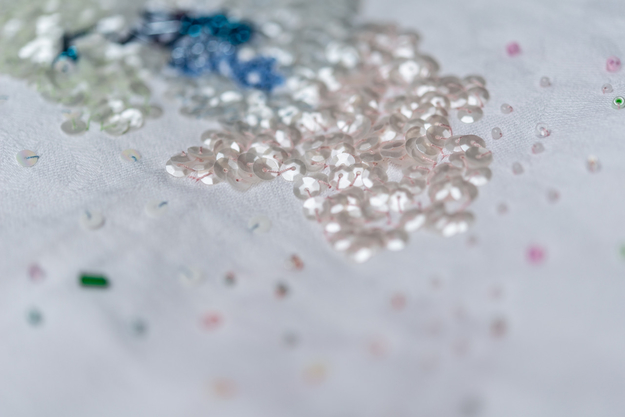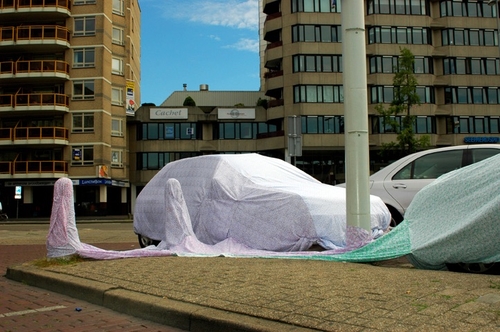When it comes to her background as a visual and textile artist, Desirée sees embroidery as her specialty and for her, there is no limit as to what can be embroidered: "Embroidery is really my thing and I use it in many ways. I even feel free to name something an embroidery even when it’s not." She started embroidering from a very young age and she was always fascinated by working with her hands, often seeing herself as a type of machine and that would make it easier for her hands to work together. We talked about the innate rhythm that goes into embroidering, which makes it a very meditating process:
"When you follow that rhythm, you are a conscious being with every movement that you make"
She further studied craft and embroidery at the Ecole Lesage art school in Paris, where she specialised in haute couture embroidery, haute couture referring to anything that is related to high-end, custom made fashion goods. When I asked her what defines and separates this type of embroidery and others, she pointed out;
"Probably everyone knows those dresses that are fully embroidered with sequins and beads and are very rich. Well, these kinds of dresses are what they make at the Maison Lesage, they do a lot of embroideries for Chanel, Dior, Balenciaga, all kinds of brands. And one of the differences is that haute couture embroidery is really rigid. Everything is under control, you have to follow the exact design, like three beads over here, and some sequins over there. There is some parts of it that have a little freedom but you need to find a rhythm that is fitting to the design. You are the maker and the design is created by someone else, so you are facilitating, you bring life to the craft. You are the hands so you have to obey. But it is also an honor to follow that design, and to be with your craft and to be in that field of the craft. It is a circle of how we behave and how we act with our work and how we honor it. There is a lot of love going in it."
From Haute Couture to Freestyle
Apart from her work in haute couture embroidery, Desirée is also very skilled and involved in freestyle embroidery and has even made up her own stitches. This combination of haute couture with DIY, freestyle, experimental practices fascinated me since I would never associate the two. It is like two different sides of the craft. Talking about the DIY character of embroidery, I brought up how nowadays, we can produce so many items mechanically, cheap and fast. But then with embroidery, you can sit for hours and make something from scratch, even though you could get it somehow easier. And I admire the skill and passion that people have and how they are devoted to making something autonomously. In that way, you get into that process and then you get closer to it as well because you've been with that item for hours, working on it and the relationship you have with it is much more personal and meaningful.
Desirée agreed, adding that "you would add specialties, like a color, or cover something you want to get rid of. You can make all the choices, make it personal. And also a way of being with yourself and being in a meditative state, focused on something, and being with your hands. It is really pleasurable I would say. It’s hard to stop and have a break sometimes. But hand work is also radical, giving something all your attention and giving it time and space especially in these days, it is also a radical act. It is a statement, with everything that is expected from us, to just take this time for yourself. It is such a different kind of movement to go inwards with your work."
Her DIY practice involves a lot of found objects as well. She often salvages things form the street and implements them in her pieces, appreciating their imperfect and damaged qualities. About these little trinkets she collects, she says: "Making these combinations feels really real to me. You can say something with these small creatures that come to you".
Another experimental aspect of her work is embroidering on objects, big or small, by covering them in textile. When it comes to larger objects, she was part of a public art project where she would be in a certain spot in the city for a period of time and would cover things like an entire car in textile, connected also to the city furniture that’s on the street and make it like an installation. What is fascinating about this project to me is that it brings textiles in public space, which is not something we are so used to seeing, changing our perspective and interaction with our material surroundings. When it comes to this public-private dimension of embroidery, Desirée sees her work as a combination of
"this in-house, focused and quiet but also the outside world, which has a lot to do with everything always, bringing in the raw, and what is there on the street into my work, or the emotions and what they bring up, meeting people or connections. "
We talked about how implementing those materials and embroidering on objects can be transformative and give deep and personal meaning to things, or change something from trash to treasure or change perspectives. How you can make something new and inspiring from something old and rigid, how you can use what is all around us. "And it doesn’t have to be a Dior bag", she says, "It can be glasses of one euro or something that you can find on the street. It can mark a moment. Because sometimes it is something that you want to remember, or something that has a special meaning in a special time and you want to keep it, and make an altar for it. And something that has really no value can become very valuable when you give it that space and give it that attention. And working with your hands and with the things that are important to you and give your life meaning, they can become something."
We came to the conclusion that this transformative re-use is also about appreciation, respect for materials, and being inventive with what is all around; "Everything is made. We produce so much, and there is so much trash, all the things people leave on the ground, it is weird and surprising how that can happen. And for a while, that was something very broad in my work, picking those things up. Now it is a natural thing to me, I don’t even think about it anymore. But thinking again, what it means that something is produced and made and is material and thinking of what it does to the earth. And even if it is cheap or made in a factory, it is still still made by people somewhere around the world. And instead of throwing it away, you can alter it and give it purpose."
Radical Embroidery workshop
As I mentioned above, Desirée has been giving many embroidery workshops in different contexts, and even gave a couple during our Inhuman Carnaval program at Dutch Design Week 2021. I asked her what is more unique, or different, about the Radical Embroidery workshop that we have been putting together:
"What I think is really special is that we will really dive into my work and work with objects that people can bring, maybe found on the street or maybe hold special meaning to them, and we will wrap them and embroider on them. But we will also learn techniques. Haute couture embroidery is something that is of course very interesting for a workshop but we will mix that up very rapidly with freestyle embroidery, that goes with your own kind of mood and with what fits your objects. I have a series of objects that I wrapped up during my life as an artist, so we will make similar things and put them together in everyone’s own style. I think this makes this workshop very different from other workshops that I do."
So the workshop leaves a lot of freedom for experimentation, both to the participants and to Desirée herself. She is looking forward to bringing that freestyle vibe to the workshop and encouraging people to make up their own stitches and get the mood that they want to bring into the work into their stitches. So, if you ever wanted to make your own identity stitch, this is the time!
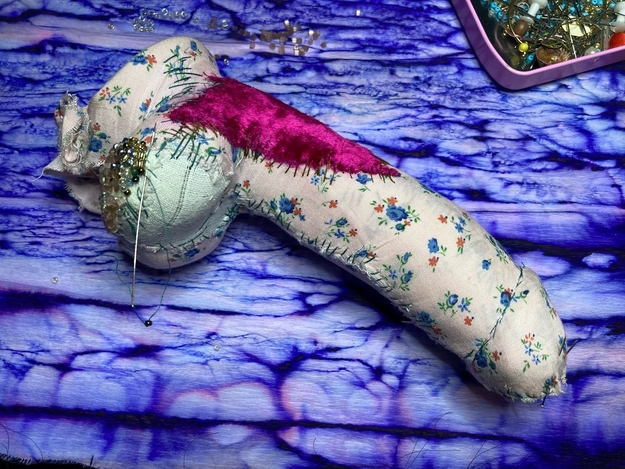
"I am looking forward to it and curious about what we will come up with. I feel like it is also intimate. Also the taboo aspect of it. That’s also special and interesting to me. Because it means that we will dive more into personal stories, we will maybe talk about things and see where it goes. I am sure we will have a very good time together, a good atmosphere, and good energies. An open space and the experience of being part of something, being connected with other people and with your work. Cozy times. A cozy workshop, but also learning techniques and elevating your creativity."
You can find more information on the upcoming Radical Embroidery workshop here
